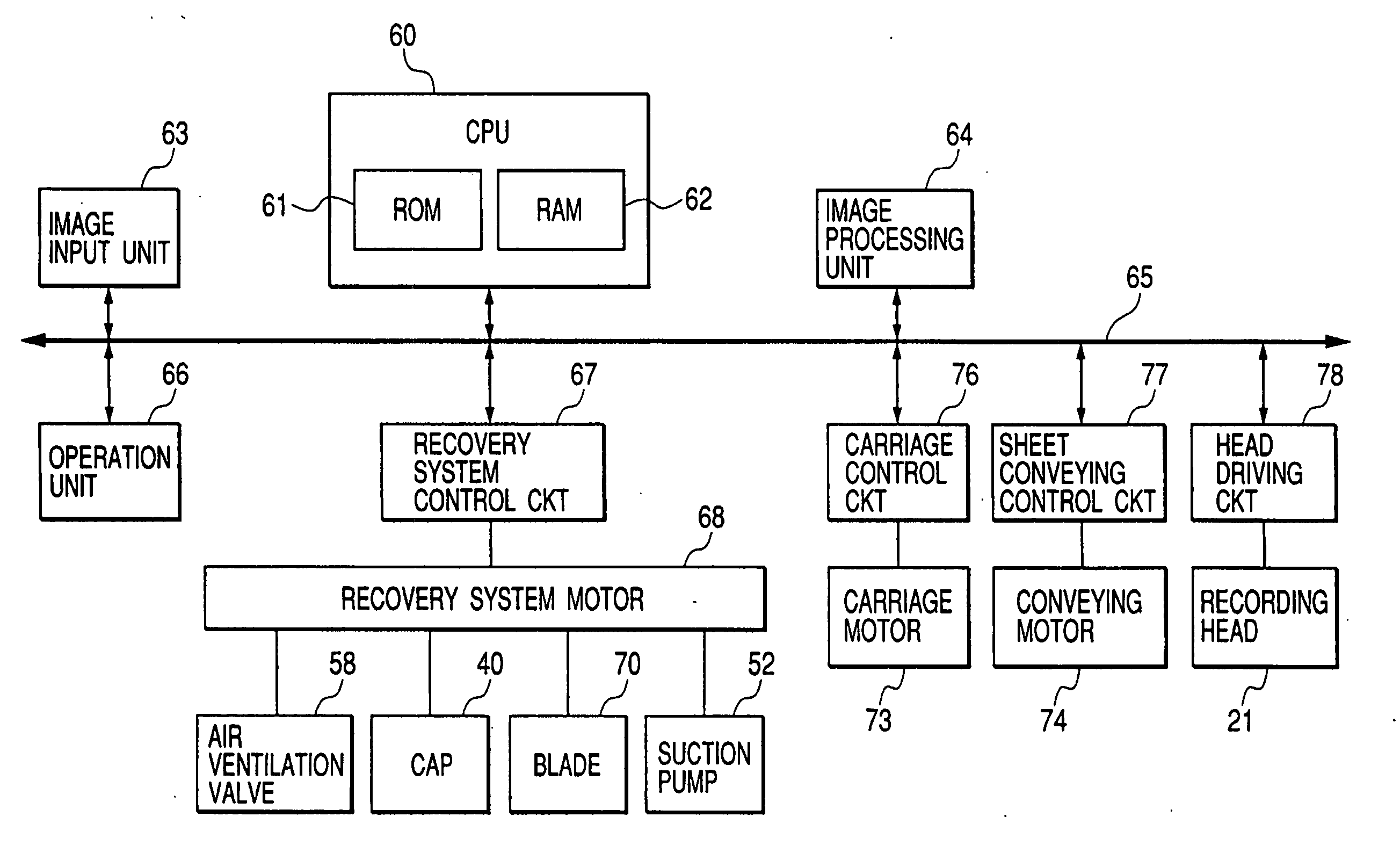Inkjet recording apparatus for controlling recovery operation by managing cap-open state and recovery control method
a recording apparatus and recovery control technology, applied in the direction of printing, other printing apparatus, etc., can solve the problems of deteriorating recording state, affecting the quality of recording, so as to reduce the amount of consumed ink, suppress the occurrence of defective ejection, and improve the quality of recording.
- Summary
- Abstract
- Description
- Claims
- Application Information
AI Technical Summary
Benefits of technology
Problems solved by technology
Method used
Image
Examples
first embodiment
[0045] First, a first embodiment of the present invention having the characteristic arrangements of the invention will be described.
[0046] In the first embodiment, the inkjet recording apparatus arranged as shown in FIGS. 1 and 2 executes the following control operation.
[0047] At the start of printing, the recording head 21, which is covered with the cap 40 in the recovery system 50 disposed at the home position, is set to a cap open state by being separated from the cap 40, and the printing is started by starting a cap-open timer as soon as the cap 40 is opened. Then, the period during which the cap is opened is cumulated by the cap-open timer, and when the cumulated period exceeds a predetermined period Th, a recovery control such as suction is executed. When the recovery suction is executed, the cap-open timer is reset.
[0048] First, a cap-open timer suction control, which is executed when the cap is continuously opened, will be explained with reference to the flowchart of FIG....
second embodiment
[0057] Next, a second embodiment of the present invention will be explained in detail.
[0058] In the second embodiment, a recovery operation is controlled by calculating a consumed ink amount in order to reduce ink consumption by further reducing the number of times of suction processing executed when a cap-open timer operates as in the first embodiment. Note that the consumed ink amount is calculated by a dot counting method. The dot counting method is a method of counting the number of dots formed by inks droplets ejected in recording, and the consumed ink amount can be estimated by counting data based on which inks are ejected. Note that although each ink droplet can be used as a unit of count in the dot count, a predetermined number of dots may be used as the unit of count. In the second embodiment, when a consumed ink amount exceeds a suction amount in cap-open timer suction, both the cap-open timer and a dot counter are reset so that no suction recovery processing is executed....
third embodiment
[0063] Next, a third embodiment of the present invention will be explained.
[0064] The third embodiment is provided with, for example, a plurality of caps and a recovery means capable of independently executing the suction recovery processing in each of the caps in the arrangement explained in the first and second embodiments. In the arrangement of the third embodiment, the discharged amount of ejected inks is measured as to each cap and the discharged amount (discharged number of dots) of each type of inks is calculated. When the consumed amounts of respective inks (consumed ink amount of C, M, Y) exceed a predetermined amount, respectively, both the cap-open timer and the dot counter are reset, and when any of them does not satisfy the above conditions, the suction recovery operation is executed.
[0065] Next, a case, in which it is determined whether or not a timer suction recovery operation is executed based on, for example, the counted value of the respective inks (C, M, Y) in t...
PUM
 Login to View More
Login to View More Abstract
Description
Claims
Application Information
 Login to View More
Login to View More - R&D
- Intellectual Property
- Life Sciences
- Materials
- Tech Scout
- Unparalleled Data Quality
- Higher Quality Content
- 60% Fewer Hallucinations
Browse by: Latest US Patents, China's latest patents, Technical Efficacy Thesaurus, Application Domain, Technology Topic, Popular Technical Reports.
© 2025 PatSnap. All rights reserved.Legal|Privacy policy|Modern Slavery Act Transparency Statement|Sitemap|About US| Contact US: help@patsnap.com



